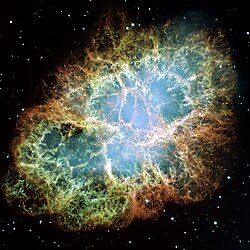
Back Ster Afrikaans Stern ALS ኮኮብ Amharic Fu'is AMI Estrela AN Ntoronyan̄ ANN तारा ANP نجم Arabic ܟܘܟܒܐ ARC نجمة (فلك) ARY



The strange shapes taken by the clouds are a result of the vast radiation emitted by these huge, hot stars.
This image combines image data with three different filters in visible light from the 1.5-metre Danish telescope at the ESO La Silla Observatory in Chile.

A star is a very large ball of bright, glowing, hot matter in space. That matter is called plasma. Stars are held together by gravity. They emit light because they are very hot. The Sun is an example of a star. It is at the center of the solar system.
The amount of material in a star (its mass) is so huge that a nuclear reaction called nuclear fusion goes on inside it. This reaction changes hydrogen to helium and gives off heat. The light and heat created by nuclear fusion makes stars very hot. It also makes bigger chemical elements. In the Sun (but not all stars) the change which takes place is the production of helium, with small amounts of heavier elements.
Stars have a lot of hydrogen. Fusion makes a lot of energy. The energy produced by stars moves (radiates) away from them. Much of the energy leaves as light, and the rest leaves as other kinds of electromagnetic radiation.
When a star like the Sun gets old, it will expand in size and become a red giant star. That will happen in about 5 billion years.